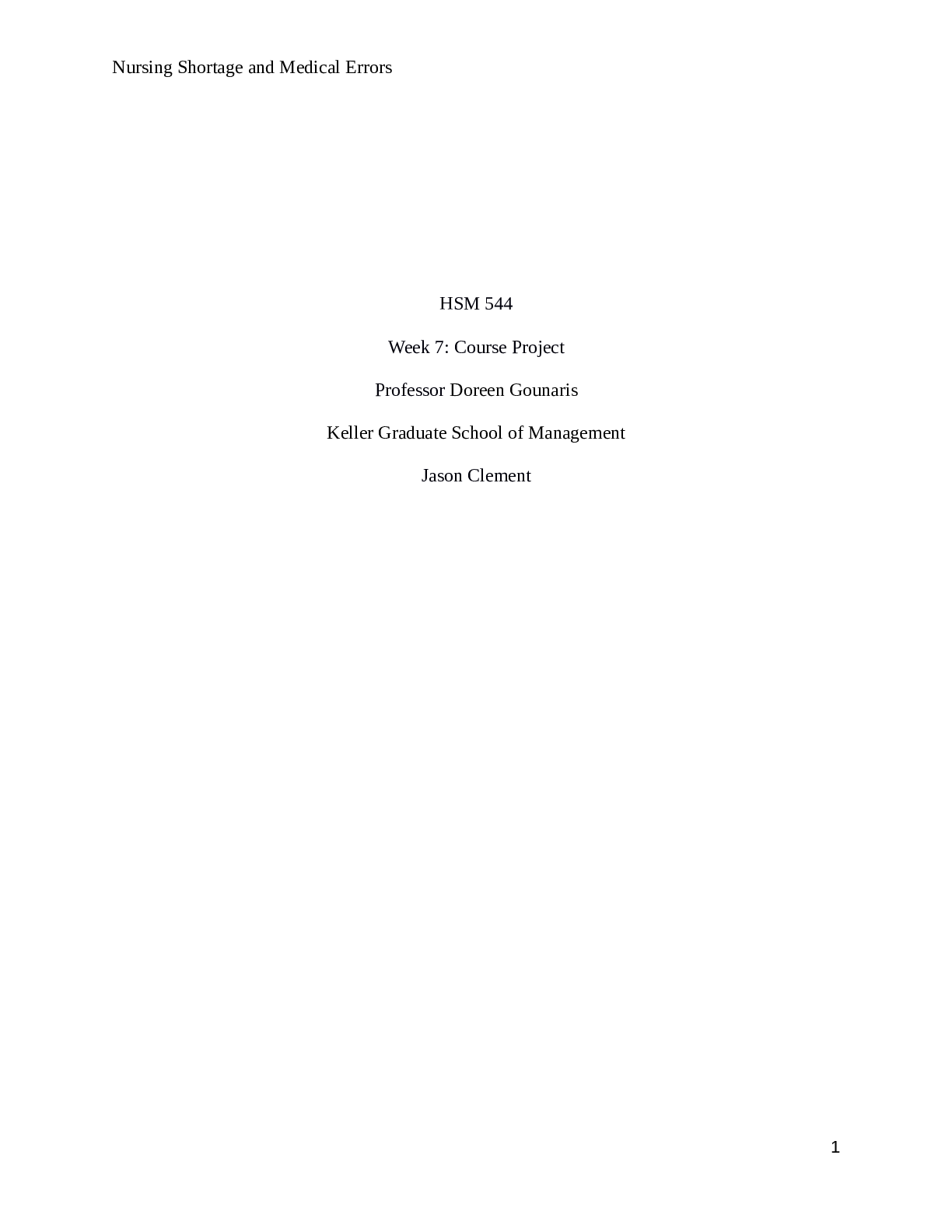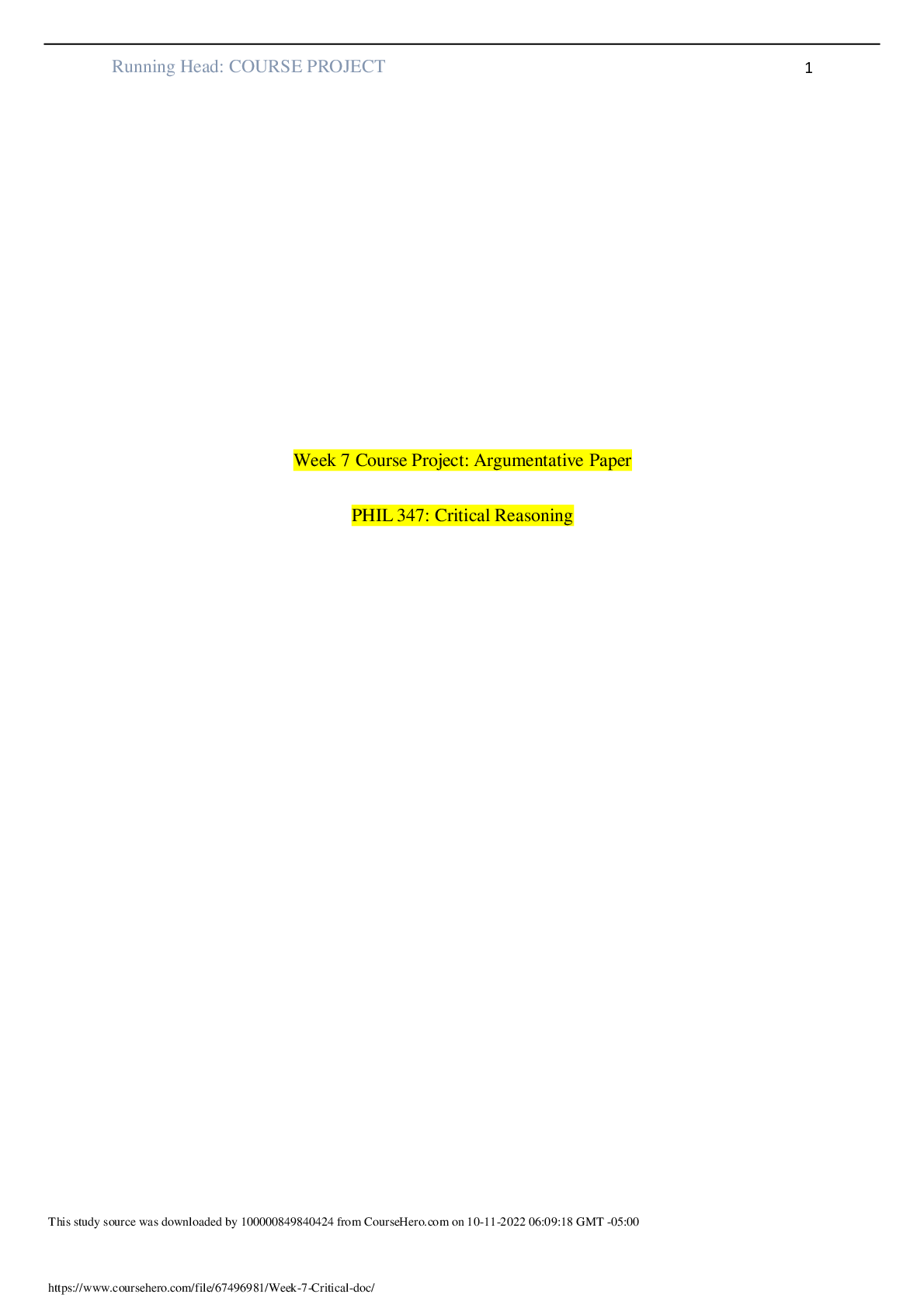Project Management > PROJECT FINAL > PROJ 420 Week 7 Course Project Final Paper: The RMP (All)
PROJ 420 Week 7 Course Project Final Paper: The RMP
Document Content and Description Below
THIS IS AN EXAMPLE OF A FINAL RMP THAT EARNED FULL POINTS NOTE THAT IS DOES NOT FOLLOW THE BOOK EXAMPLE LETTER FOR LETTER BUT DOES MEET 100% GRADING CRITERIA THAT IS IDENTIFIED UNDER THE COURSE PRO... JECT TAB (OF WHICH, I HAVE SUPPLIED AND EXAMPLE AND DOCUMENT IN DOC SHARE). I FOLLOW THE GRADING CRITERIA TO THE LETTER AS THAT IS DEVRY POLICY AND MY GUIDELINES. I HIGHLY RECOMMEND THAT YOU FOLLOW THIS EXAMPLE AS CLOSELY AS POSSIBLE WHEN COMPLETING YOUR RMP PRIOR TO TURN IN. MJD I HAVE WORKED TO MAKE THIS A GENERIC PAPER SO IF SOME OF ITS TEXT DOES NOT MAKE SENSE IT IS BECAUSE I HAVE REMOVED MOST IDENTIFIER DOCUMENTATION WITHIN THE TEXT. THIS RMP DOES TAKE SOME OF THE DETAILS TO THE MAX BUT PLEASE NOTE THAT IT MEETS 100% OF THE GRADING CRITERIA THAT IS TO BE USED. IF YOU FOLLOW THE BOOK EXAMPLE, SOME OF THE DETAILS WILL BE LEFT OUT AND OVERLOOKED AND THUS, HAVE POINTS MARKED OFF FOR VARIOUS ELEMENTS MISSING. YOUR PAPER DOES NOT HAVE TO BE 24 PAGES LONG. I AM NOT AS CONCERNED OVER LENGTH AS I AM CONTENT. JUST WORKING TO AID YOU IN COMPLETING YOUR PAPER TO THE BEST OF YOUR ABILITIES. GOOD LUCK AND I KNOW EVERYONE WILL BE SUCCESSFUL! MJD TABLE OF CONTENTS INTRODUCTION 3 PROJECT DESCRIPTION AND OBJECTIVES 3 Project Costs 4 AIMS, SCOPE AND OBJECTIVE OF RISK PROCESS 5 APPLICATION OF THE ATOM PROCESS 5 RISK TOOLS AND TECHNIQUES 6 ORGANIZATON ROLES AND RESPONSIBILITIES FOR RISK MANAGEMENT 8 RISK REVIEWS AND REPORTING 9 APPENDIX A - Definitions of Probability and Impacts 11 APPENDIX B - Standard Risk Breakdown Structure (RBS) for the Way to Pay for the SMV Bill Acceptor project 14 APPENDIX C - Sample contents list for a full risk report 16 Executive Summary 16 Scope and Objectives of Report 17 Overall Risk Status 17 Top Risks, Actions and Owners 18 Changes since Last Review 18 Conclusions and Recommendations 18 APPENDIX D - Sample contents list for a summary risk report 20 Appendix E - Risk Registry for the Way to Pay for SMV Bill Acceptor Project 21 Appendix G - Project Sizing - Way to Pay for a Bill Acceptor Project 23 RISK MANAGEMEMENT PLAN FOR THE WAY TO PAY FOR THE SMV BILL ACCEPTOR PROJECT INTRODUCTION This document is the Risk Management Plan for the Way to Pay for the SMV Bill Acceptor Project, and defines the risk management process to be used during the life of this project. “The Risk Management Plan provides the blueprint of overseeing risk management throughout the project describing who, what, when, where, why, and how “(Elyse 2007). The Project Manager, student, is responsible for implementing, reviewing and maintaining this risk Management Plan during the project, to ensure that the risk process remains appropriate to deal wit the level of risk faced by the project. PROJECT DESCRIPTION AND OBJECTIVES Description: XYZ Company developed a credit card reader bezel that fits onto their SMV family of bill acceptor products to enable consumers to conduct either cash or credit/debit card transactions in the same bill acceptor footprint of a vending machine. XYZ’s parent company, Crane Merchandising, also owns a vending machine manufacturing division, Crane Vending Solutions (ABC), which installs XYZ’s payment products into the variety of vending machines they manufacture. This document covers the launch phase of the project. Objectives: The objectives for the Way to Pay for the SMV Bill Acceptor Project are summarized as follows: 1. Completing successful field trials 2. Introducing this payment option into the Crane Vending Solution’s manufacturing lines 3. Establishing the supply chain deliverables 4. Preparing all marketing materials for the official launch at the industry trade show targeted at the end of April. Strategic Importance: This project is a key business initiative as XYZ is relatively new into the industry, acquired by Crane Merchandising in 2008, and is the only competitor without this type of payment option. XYZ working with the ABC, has been given the highest priority by Crane Merchandising to achieve aggressive growth targets in the vending industry. As the product manager, this is one of my highest priorities as all objectives must be met by the end of April. Quality: The launch activities focused on determining product readiness includes both a field trial and manufacturing integration. The project will follow these activities and report against the following metrics. Field Trial: 1. Field Trial Unit Days: 4,500 2. Out of box failures: 0 unresolved 3. Field Failures: 0 unresolved 4. VOC: Reflect customer satisfaction a. Sales uplift >/= 10% b. Service Calls: 0 increase Manufacturing: 1. Machine Yields:: No impact to current yields 2. Incoming Inspection: <1% reject rate Project Costs: Project launch costs are estimated to be: $10,000 1. Materials: $1,200 2. Travel: $4,000 3. Labor: $4,000 4. Misc. $800 Note: Field trail units will be provided to accounts at a reduction to list price and terms of 90 days. AIMS, SCOPE AND OBJECTIVE OF RISK PROCESS Objective: The process for managing risk in the Way to Pay for the SMV Bill Acceptor Project “aims to manage all foreseeable risks (both opportunities and threats) in a manner which is proactive, effective and appropriate, in order to maximize the likelihood of the project achieving its objectives, while maintaining risk exposure at an acceptable level” (Atom P197) Scope: The risk management process covers all activities undertaken during the lifetime of the project. It is intended to cover both internal project risks as well as risks associated with external vendors, customers and corporate strategy updates. Risks associated with such projects are generally in the areas of Technical, Commercial and Management. To address these and other risks that are identified, the risk management process will execute the following which is in line with the Atom Risk Process (see APPLICATION OF THE ATOM PROCESS below). Assessment: There are three basic concerns in project management: 1. Schedule. Will the project go over schedule? 2. Cost. Will the project overrun its budget? 3. Performance. Will the output satisfy the goal(s) of the project? (Galway, 2004 p5) The process will use a risk impact assessment scale to determine which risks must be addressed in order to achieve project objectives. The risk assessment phase will prioritize project risks in order that the stakeholders can focus their attention on those areas of risk that would most affect the project objectives. “Acceptable risk” is defined for the Way to Pay for the SMV Bill Acceptor Project as those with a risk impact score that is =/<2. Communication & Ownership: The risk process will identify and engage all project stakeholders while assigning appropriate ownership to the risk management actions. Project risk based information will be communicated to all project stakeholders each week and will contain the detail associated with current and new project risks sufficient to enable modifications to the project strategy if needed deemed required. APPLICATION OF THE ATOM PROCESS The Risk Management process for the Way to Pay for the SMV Bill Acceptor Project will include the phase approached as detailed in the Atom Risk Management Process. Based on the Atom project sizing tool, this is considered a medium size project. As such, the standard ATOM process will be applied, The process will be reviewed at the project mid-point to determine if the project scope has changed sufficiently to change the project process classification. As a medium size project, the following elements of the ATOM process will be used for the Way to Pay for the SMV Bill Acceptor project. o Initiation – This phase will be completed prior to project start and will be completed within one week prior to project start. This phase targets to identify, clarify and record the objectives for the project and define the details of the risk process to be implemented. Results of the process will be documented n the Risk Management Plan. o Identification – This phase is the 1st phase of the risk management process and is designed to identify risks, both positive and negative, which might affect the project objectives. o Assessment – Once the risks have been identified, the risks are evaluated, both quantitatively and/or quantitatively, to determine which areas of the project are most at risk. o Response Planning – After the risks are identified and assessed and prioritized, then the appropriate strategies and actions are defined to address the risks. Owners of the risk items are also assigned in this stage. o Reporting – communicating the status of all the risks associated with the project to all the stakeholders will occur on a weekly basis. o Implementation – Once the response actions have been agreed and owners assigned, then the actions are implemented, checking status to determine effectiveness each week or when appropriate. o Review – Reviews will be held weekly to identify new risks associated with the project as well as to assess the status of the current risks and the effectiveness of the actions applied. o Post Project Review – A final review will be held to identify and document the lessons learned from the project to improve the risk management for future projects as well as the overall process of Project Management. RISK TOOLS AND TECHNIQUES The following tools and techniques listed in each risk management phase will be used to support the risk management process for the Option for the SMV Bill Acceptor project. Initiation o Project Plan (including project Scope and Objectives) o Risk Management Plan (capture output of initiation meeting Identification: Risks will be identified using the following techniques. o Documentation Review – review previous project files, contract as well as project documentation, including plans, assumptions, objective and constraints for the Option for the SMV Bill Acceptor project. o Delphi Technique – to help reach consensus and reduce bias in identifying risks. (Kerzner, P922) o brainstorming Meetings – attended by project team, multidisciplinary set of experts and key suppliers to obtain a comprehensive list of project risks. o review of standard risk checklist and risk register from past similar projects. o Diagramming Techniques – Cause and effect diagrams to aid in identifying causes of risks. o ad-hoc identification of risks by project team member and stakeholders at any time during the project. o Initial risk Register to record identified risks for further assessment. o Modeling and simulation – “…use model that translates the specified detailed uncertainties of the project into their potential impact on objective” (PMBOK p299). Assessment o Probability and Impact Assessment for each identified risk, using the project-specific scales defined in Appendix A. o Double P-I Matrix to aid in prioritizing risks for action, using the standard Risk Scoring calculations base on probability (P) and impact (I). see Appendix A o Top Risk List for priority management attention. o Risk Categorization using the standard Risk Breakdown Structure (see Appendix B) to identify patterns of exposure. o Risk Register update to include assessment data. Response Planning o Response strategy Selection as appropriate for each identified risk, including owner allocation. o Identification of specific Actions and Action Owners. o Risk Register update to include response data.(Appendix E) Reporting (see Appendix C) o Risk Report to Project Sponsor and Stakeholders. o Provision of ad-hoc reports stakeholders and Project Team as required. Implementation o Implementation of response strategies via their agreed actions by agreed owners. o Monitoring of the effectiveness of agreed actions and updating of project plans. Review (see section below on risk reporting) o A risk review meeting as part of a Minor review to identify new risks, review progress on existing risk and agreed responses, and assess effectiveness of actions. o A risk workshop as part of a Major review to identify new risks, status of existing risks, effectiveness of risk process and impact on key objectives. Post-Project Review o A lessons-learned meeting to capture all lesions learned relating to risk management on the Option for the SMV Bill Acceptor project. ORGANIZATON ROLES AND RESPONSIBILITIES FOR RISK MANAGEMENT The responsibilities of key project stakeholders for risk management of the Option for the SMV Bill Acceptor project are summarized as follows. Project Sponsor o Actively support and encourage Project Manager: (2.1.2 Health & Human Services) o review, analyze, and approve mitigation strategies for all levels of risk-impact rating, o provide the overall project risk strategy o coordinate with the Risk Management Team o provide the direct link to Executive Project Sponsors o Promote risk management process for the project o Determine acceptable levels of risks o write and approve the Project Risk Management Plan o define the Risk Management process, o participate in the Risk Management process, o take ownership of risk mitigation planning and execution Risk Champion: In this project, the Project Manager will perform the duties of the Risk Manager. o Select and implement a project risk management methodology o Develop a project risk management strategy/plan o Implement a project risk management infrastructure o Generally manage within the risk management context, for example setting objectives, forecasting, planning, organizing, directing, coordinating, controlling and communicating o Create and maintain Risk Register Risk Owner: In this project, the Risk Owner also assumes the responsibilities of the Action owner. o Develop the actions for the risks assigned. o Implement agreed actions. o Monitor and report progress, recommend any other actions needing risk management. o Project Team Member o Actively participate in the risk process and proactively identify new risks. o Provide inputs to the project manager for risk reports. RISK REVIEWS AND REPORTING Reviews: The risk exposure on the Option for the SMV Bill Acceptor project will be review weekly at Minor reviews and once at the project’s mid point at a Major review during the life of the project. At both type of reviews, new risks will be identified and assessed, the status of existing risks will be reviewed, progress on agreed actions will be assessed, and new actions and/or owners will be allocated where required. At the Major review, the effectiveness of the risk process will be reviewed to determine whether changes to the approach, tool, or techniques are required. Where process changes are identified and agreement to these changes has been reached with the project sponsors and the project manager, this Risk Management Plan will be updated and reissued to document the revised process. Reporting: A risk report will be issued weekly by the Project Manager to all sponsors and stakeholders after each Major and Minor review. Contents for the reviews can be found in Appendix C for Major Reviews and Appendix D for Minor Reviews. During the team meetings, each member will be provided a listing of risks and actions for which the individual is responsible. On completion of the project, the risk register will be updated with details concerning risks that may affect other similar projects and project lessons learned documented. APPENDIX A - Definitions of Probability and Impacts Note: Cost impact includes project cost as well as opportunity cost of lost sales. Project Impact Scale Scale Impact VHI 9-10 HI 7-8 MED 4-6 LO 2-3 VLO 0-1 NIL <1% Risk Probability, Impact and Response table for the Way to Pay for the SMV Bill Acceptor project Risk Item Risk Probabilit y Impact Response Scope changes will Ensure scope management plan is 1. arise during project High Medium in place and all sponsors and team which may prevent .65 6 members understand and agree on meeting time and cost the definition of a scope change. objectives. Requirements Ensure change management 2. Definition – Field Medium Medium process is in place and Trial may uncover .45 4 communicate how changes will be new requirements handled (ie. running change / new which will lead to project, etc.) schedule slippage. Solution does not Business needs frequently change. 3. meet the business Low High Project will be planned to adjust needs which will lead .15 7 rapidly to changing needs. Project to lower than will be phased in short incremental expected sales. steps to minimize exposure. 4. Technical Interface issues between product and 3rd party telemeter may result in delays of further deployment Medium .33 Low 2 Ensure collaboration between engineering departments on lab system testing. Gain commitment from 3rd party to actively participate in field trials and issue resolution. 5. Reliability: Field reliability issues may undermine consumer confidence which will jeopardize objectives. Low .25 High 7 Conduct weekly testing review prior to field deployment. Make sure field technical associates provide high priority attention to any reported field issue and ensure a communication plan is in place to address the issues internally and externally. 6. Operations Management – project may not be given sufficient priority in manufacturing which will result in delays to launch to the field. Medium .48 Medium 4 Work with Manufacturing Management to help them to understand that the project will improve overall sales of machines and support from both external companies will help ease product into manufacturing. Have them participate in team milestone meetings. 7. Resourcing: Recent organizational changes has reduced needed technical support staff which may affect project timeline. Medium .40 Medium 5 Gain support from client technical support team and provide customers with feedback process and appropriate audit tools. 8. Communications: Customers may commit orders before knowing site signal strength which will result in customer frustration and unnecessary returns. High .58 VLow 1 Develop order processes for sales and customer service associates to ensure signal strength is confirmed prior to shipping product to site. 9. Suppliers & Venders Potential of conflict of interest exist which may cause undermine the support required Very High .80 Very High 9 Communicate and agree on strategic plans of both companies with regards to the project. Obtain long term commitment under contract. from a key vendor. This could stop the project. 10. Client/Customer Stability – Client may withdraw prior to trial which will result in delays to launching the product. Low .12 Medium 5 Target field trial sites with high potential to benefit. Review expected results with client prior to installation. Probability- Impact Matrix Way to Pay for the SMV Bill Acceptor project Negative Impact Positive Impact P VHI VHI P R 0.9 R O HI 1 9 HI O B 0.7 B A MED 8 T O MED A B 0.5 2,6 B I LO 7 3 LO I L 0.3 4 5 L I VLO 10 VLO I T 0.1 VLO LO MED HI VHI VHI HI MED LO T Y 1 3 6 8 10 10 8 6 3 Y Green Amber Red Risks Risks Risks Risk Catagorization Technical Risks = 4 Management Risks = 4 Commercial Risks = 2 APPENDIX B - Standard Risk Breakdown Structure (RBS) for the Way to Pay for the SMV Bill Acceptor project Following are the risks associated with this project that have been identified thus far. RBS Level 0 RBS Level 1 RBS Level 2 Project Risks 0. Project Risk 1. Technical Risk 1.1 Technical Scope Definition Scope changes may (will) arise during project (ie. new commands, wiring, etc.) 1.2 Requirements Definition Field trials may uncover new requirements as customers use product. 1.3 Technical Interfaces Bezel and Telemeter may experience unexpected interactions Consistency of AT&T signal strength 1.4 Reliability Target field trial reliability targets may be unattainable. 2. Management Risk 2.1 Operations Management Project may not be given sufficient priority in manufacturing. New manufacturing processes may be difficult to control. 2.2 Resourcing Recent technical support re- organization may impact ability to complete field audits 2.3 Communications Customers may commit orders before knowing site signal strength. Potential confusion about who to contact for support issues. 2.4 Business By the time the launch occurs, business needs may have changed sufficiently enough to undermine the objectives of the project RBS Level 0 RBS Level 1 RBS Level 2 Example Risks 0. Project Risk 3. Commercial Risk 3.1 Suppliers & Vendor A potential conflict of interest between external supplier and sister company may have impact on future supply. Telemeter Supplier’s strategic direction may result in competing commercial interests. Scope change as supply chain into manufacturing is unknown. 3.2 Client/Customer stability Client may withdraw prior to trial completion due to product not meeting sales expectations Competition may undermine trials by providing more attractive offer APPENDIX C - Sample contents list for a full risk report - EXECUTIVE SUMMARY - SCOPE AND OPBJECTIVES OF REPORT - PROJECT STATUS SUMMARY - OVERALL RISK STATUS - TOP RISKS, ACTIONS AND OWNERS - DETAILED RISK ASSESSMENT • High/Medium/Low Risks • Causal Analysis (Mapped to RBS) • Effects Analysis (Mapped to WBS_ - CONCLUSIONS AND RECOMMENDATIONS - APPENDICES • Complete Risk Register • Prioritized Risk List Full Risk Report for the Way to Pay for the SMV Bill Acceptor project 4/16/2011 Executive Summary As with all projects, the Example RMP PROJ 420 Project contains uncertainties that have the potential to undermine its objectives by causing cost overruns and delays. To help identify these risk items and develop recommendations to mitigate or eliminate these risks, the project team adopted the Atom methodology of risk management that covers several phases for managing risks, including risk identification and assessment. Based on the completion of these two phases, the team is providing what is seen as the major risk components associated with this project as well as the recommendations towards their mitigation. In summary, there were ten risks identified for the project, however, during the assessment phase it was determined that three of the risks scored high enough to highlight here. These risks, along with the team’s recommendations, are: 1. Supplier & Vendors – A potential conflict of interest between external supplier and our sister company who is planning to launch product which will be in direct competition to our current supplier. The current supplier may pull back their support which can result in the need to find alternate suppliers or change the supply chain strategy which will affect our customer offering and timetables. o Recommendation: Meet with principles of both companies and obtain agreement (with principles) on strategic plans of both companies with regards to the project. Obtain long term commitment under contract 2. Technical Scope Definition - Due to the newness of the technology to our development team, the team may determine that a technical solution is not feasible with in-house talent causing project delays and will require us to seek external experts which will drive the project over budget. o Recommendation: Identify experts in the technical field prior to project start and place them on retainer. If risk occurs, Initiate scope management process; communicate to all sponsors and team members, review options with team and execute solutions. Review project schedule to determine if slack can be used to minimize schedule impact. 3. Resourcing - The lack of appropriate resources for the field trial may delay field deployment and result in delays in project completion. o Recommendation: Gain support from client technical support team and provide customers with feedback process and appropriate audit tools. Conclusion: The risks identified here are manageable and will be actively managed, along with the other 7 risks, under the Atom Risk Management process. Scope and Objectives of Report The main purpose of this report is to communicate the current status of the risks elements associated with the undertaking of the Example RMP PROJ 420 Project to all project stakeholders and sponsors. The report provides a comprehensive listing of all the risks that have been identified thus far, the status of these risks, the owners, actions and recommendations viewed to mitigate these risks. Overall Risk Status There are 10 identified risks that have been categorized and assessed. Risk owners have been identified for each risk and preliminary risk mitigation plans have been developed, including actions. The risk register has been updated and risk reviews are planned. Base on the assessment results, the main areas of risk have been categorized to be in Commercial (outside vendors), the Technical Scope (internal technical know-how) and resourcing (field resources). Of these, the risk associated in Commercial is most significant as a vendor issue may completely undermine the project. The Senior Commercial Manager has been assigned to work with the vendor to ensure ongoing product supply. Probability of success is good. Although it has been determined that avoidance is not an appropriate response to the top risks, remaining risks have been deemed manageable within our risk management process with a high likelihood of successful mitigation. Top Risks, Actions and Owners Project Name: Cashless Option for a Bill Acceptor Risk Action Owner Supplier & Vendors – A potential conflict of interest between external supplier and our sister company who is planning to launch product which will be in direct competition to our current supplier. The current supplier may pull back their support which can result in the need to find alternate suppliers or change the supply chain strategy which will affect our customer offering and timetables. Meet with principles of both companies and obtain agreement (with principles) on strategic plans of both companies with regards to the project. Obtain long term commitment under contract VP Commercial Technical Scope Definition - Due to the newness of the technology to our development team, the team may determine that a technical solution is not feasible with in-house talent causing project delays and will require us to seek external experts which will drive the project over budget Identify experts in the technical field prior to project start and place them on retainer. If risk occurs, Initiate scope management process; communicate to all sponsors and team members, review options with team and execute solutions. Review project schedule to determine if slack can be used to minimize schedule impact. Engineering Manager Resourcing - The lack of appropriate resources for the field trial may delay field deployment and result in delays in project completion. Gain support from client technical support team and provide customers with feedback process and appropriate audit tools. Sales Manager Changes since Last Review Since our last review, owners have been assigned to all risk items, actions have been defined and the risk register has been updated. No new risks have been identified. Conclusions and Recommendations Conclusions: Based on the risk assessment performed on all the identified risks, the high level risks associated with our supply chain (Red), in-house technical ability (Amber) and external field resources (Amber), warrant immediate mitigation actions to take place to ensure these do not occur. The additional 7 risks had low scores and will be managed within the risk management process. Risk #1: Supplier & Vendors - Risk of losing key supplier due to conflict with sister company. Status: RED Owner: Commercial VP Recommendations / Actions: o Define position and develop contract that will address risk and create a win-win relationship. Target completion: 4/15. o Schedule meetings with the principles of both companies and obtain agreement (with principles) on position and obtain contract agreement from supplier. Target completion: 4/28 Risk #2: Technical Scope Definition – Risk that in-house technical knowledge is insufficient. Status: Amber Owner: Engineering Manager/Project Manager Recommendations/Actions: o Identify experts in the technical field and place them on retainer (EM). Target completion 5/1. o Review project schedule to determine if slack can be used to minimize schedule impact. Target completion 4/18 (PM). Risk #3: Resourcing - The lack of appropriate resources for the field trial may delay field deployment and result in delays in project completion Status: Amber Owner: Sales Manager Recommendation/Actions: o Obtain client agreement to use their technical support team. Target completion 4/12. o Provide client with feedback process and appropriate audit tools. Target completion 4/25 o Identify additional contract resources within industry. Target completion 4/25 APPENDIX D - Sample contents list for a summary risk report - EXECUTIVE SUMMARY - SCOPE AND OBJECTIVES OF REPORT - OVERALL RISK STATUS - TOP RISKS, ACTIONS AND OWNERS - CHANGES SINCE LAST REVIEW - CONCLUSIONS AND RECOMMENDATIONS - APPENDIX • COMPLETE RISK REGISTER IN PRIORITY ORDER Appendix E - Risk Registry for the Way to Pay for SMV Bill Acceptor Project Risk Registry Project Name: Cashless Option for a Bill Acceptor Risk Risk Category Probability Impact Risk Score Risk Rank Recommendation / Action Owner Supplier & Vendors – A potential conflict of interest between external supplier and our sister company who is planning to launch product which will be in direct competition to our current supplier. The current supplier may pull back their support which can result in the need to find alternate suppliers or change the supply chain strategy which will affect our customer offering and timetables. Commercial 0.8 9 7.2 1 Meet with principles of both companies and obtain agreement (with principles) on strategic plans of both companies with regards to the project. Obtain long term commitment under contract VP Commercial Technical Scope Definition - Due to the newness of the technology to our development team, the team may determine that a technical solution is not feasible with in-house talent causing project delays and will require us to seek external experts which will drive the project over budget Technical 0.65 6 3.9 2 Identify experts in the technical field prior to project start and place them on retainer. If risk occurs, Initiate scope management process; communicate to all sponsors and team members, review options with team and execute solutions. Review project schedule to determine if slack can be used to minimize schedule impact. Engineering Manager Resourcing - The lack of appropriate resources for the field trial may delay field deployment and result in delays in project completion. Management 0.4 5 2 3 Gain support from client technical support team and provide customers with feedback process and appropriate audit tools. Sales Manager Operations Management - An impact to the project schedule may occur if insufficient priority is given to introducing the project into manufacturing. Management 0.48 4 1.92 4 Work with manufacturing management to help them to understand that the project will improve overall sales of machines and support from both external companies will help ease product into manufacturing. Have them participate in team and have manufacturing senior management attend milestone meetings. Value Stream Manager Technical Requirements Definition - Due to machine variations, new requirements will be found during field trials that will require enhancements to the product, causing project scope creep. Technical 0.45 4 1.8 5 Review issue and decide if it is a requirement for this project or can be held to a follow-on project of enhancements. If required in this project, execute change management process. Product Manager Reliability - Due to unfamiliarity of applications, failure to meet reliability targets may occur that will have an impact on the overall viability of the project. Technical 0.25 7 1.75 6 Assemble SWAT team consisting of Manf. And design engineers as well as field and quality assurance personnel to review reported quality issues and tasked to developing/implementing solutions. Set-up daily status communication system to include sponsors and customers. Technical Support Manager Business - Overall project objective may be undermined due to a change in business needs which could result in closing the project. Management 0.15 7 1.05 7 Implement several project gates to review project status with senior management and obtain approval prior to proceeding. Project Manager Technical Interfaces - Impact to schedule may occur due to unexpected required changes due to the interaction between the bezel and external devices. Technical 0.33 2 0.66 8 1. Contact supplier of external device and engage their engineering team with ours. 2. Develop appropriate SW and confirm solution with device supplier.3. Review schedule to determine if this was on the critical path and, if so, seek slack in other areas maintain schedule. Engineering Manager Client/Customer - The field trial clients can undermine the overall project objectives by withdrawing interest prior to trial due to decisions to go with competitors.. Commercial 0.12 5 0.6 9 Review circumstances with sales team and develop an offer and contract that would compel cooperation. Customer Service Manager Communications - Planned launch volumes may be in jeopardy due to potential customer frustration if product arrives at a site with insufficient signal strength. Management 0.58 1 0.58 10 1. Develop sales tools for FSEs and training course for customer service. 2. Distribute sales tools and conduct training of customer service. Technical Support Manager Key Terms Risk: The risk stated in a complete sentence which states the cause of the risk, the risk, and the effect that the risk causes to the project. Risk Category: Categorization of risks by area of project affected, source of risk or other useful category. Probability: The likelihood that a risk or opportunity will occur (on a scale from 0 to 1 with 1 being the highest). Impact: The impact of the risk on the project if the risk occurs (scale from 0 to 10 with 10 being the highest). Risk Score: Determined by multiplying probability and impact (scale from 0 to 10). Risk Ranking: A priority list which is determined by the relative ranking of the risks (by their scores) within the project with the number one being the highest risk score. APPENDIX F - Project Sizing and Stakeholder Analysis for the Way to Pay for SMV Bill Acceptor Project Stakeholder Area of Interest Attitude (+/-) Power (+/-) Interest (+/-) Stakeholder Type Project Manager (XYZ) Project Completion on time/ budget/Quality + + + Savior Engineering Director (XYZ) Product performance to spec. + + - Sleeping Giant Sales Director (XYZ) Sponsor + + + Savior Customer Service Mgr. (DEF) Updating CS systems, CMS training + - - Acquaintanc e Product Manager (XYZ) Completion of marketing plan + + + Savior Field Support Mgr. (DEF) Intro. Product to tech. reps. + - + Friend Mfg. Manager (DEF) Processes to introduce to mfg – quality + - - Acquaintance Mfg. Manager (XYZ) Performance to spec. + - + Friend VP Sales (DEF) Sponsor – launch to sales team + + - Sleeping Giant Marketing Director (XYZ) Sponsor - + + Saboteur General Mgr. (XYZ) Sponsor + + + Savior General Mgr. (DEF) Sponsor + + - Sleeping Giant President Sponsor - + + Saboteur Procurement Manager (DEF) Supply Chain - - - Tripwire Finance Manager (DEF) Mfg. cost - + - Time Bomb Finance Manager (XYZ) Mfg. & transfer cost, Project cost - + + Saboteur Quality Mgr. (XYZ) Quality Assrance + - + Friend Appendix G - Project Sizing - Way to Pay for a Bill Acceptor Project Criterion Value = 2 Criterion Value = 4 Criterion Value = 8 Criterion Value = 16 Criterion Score Strategic Importance Major contribution to business objectives 8 Commercial Complexity Minor deviation from existing commercial practices – combine w/external product 4 Essential Constraints And Dependencies Key project objectives depend on external factors – Acceptance by operators 8 Requirement Stability Some requirement uncertainty, minor changes during project 4 Technical Complexity Enhancement of existing product – Option to current offering 4 Project Duration Duration 12 months 4 Project Value Significant project value ($1M) 4 Project Resources Medium in-house team 4 Market sector regulatory characteristics Standard regulatory framework 4 Post-project liabilities Acceptable exposure 4 Total 48 Criterion >/= 75 Large project 35-74 Medium project <35 Small Project Citations Kerzner, H., PHD (2001). Project Management. A SYSTEMS APPROCH TO PLANNING, SCHEDULING, AND CONTROLLING. Hillson, D. & Simon, P (2007). Practical Project Risk Management, The Atom Methodology. Project Management Institute (2008). A Guide to the Project Management Body of Knowledge (PMBOK Guide) – Fourth Edition. Health & Human Services Agency, Office of Systems Integration, California (8/29/2011), Risk Management Plan (Template), retrieve on 4/15/2011 from http://www.bestpractices.osi.ca.gov/sysacq/documents/Risk%20Management%20Plan%20(3283).doc Elyse, PMP (2/6/2007). Risk Identification. Retrieve on 2/14/2011 from http://www.anticlue.net/archives/000816.htm Galway, L. (2/2004). Quantitative Risk Analysis for Project Management. A critical Reviiew. Retrieved on 4/14/2011 from http://www.rand.org/pubs/working_papers/2004/RAND_WR112.pdf [Show More]
Last updated: 11 months ago
Preview 1 out of 24 pages

Reviews( 0 )
Document information
Connected school, study & course
About the document
Uploaded On
May 31, 2023
Number of pages
24
Written in
Additional information
This document has been written for:
Uploaded
May 31, 2023
Downloads
0
Views
36


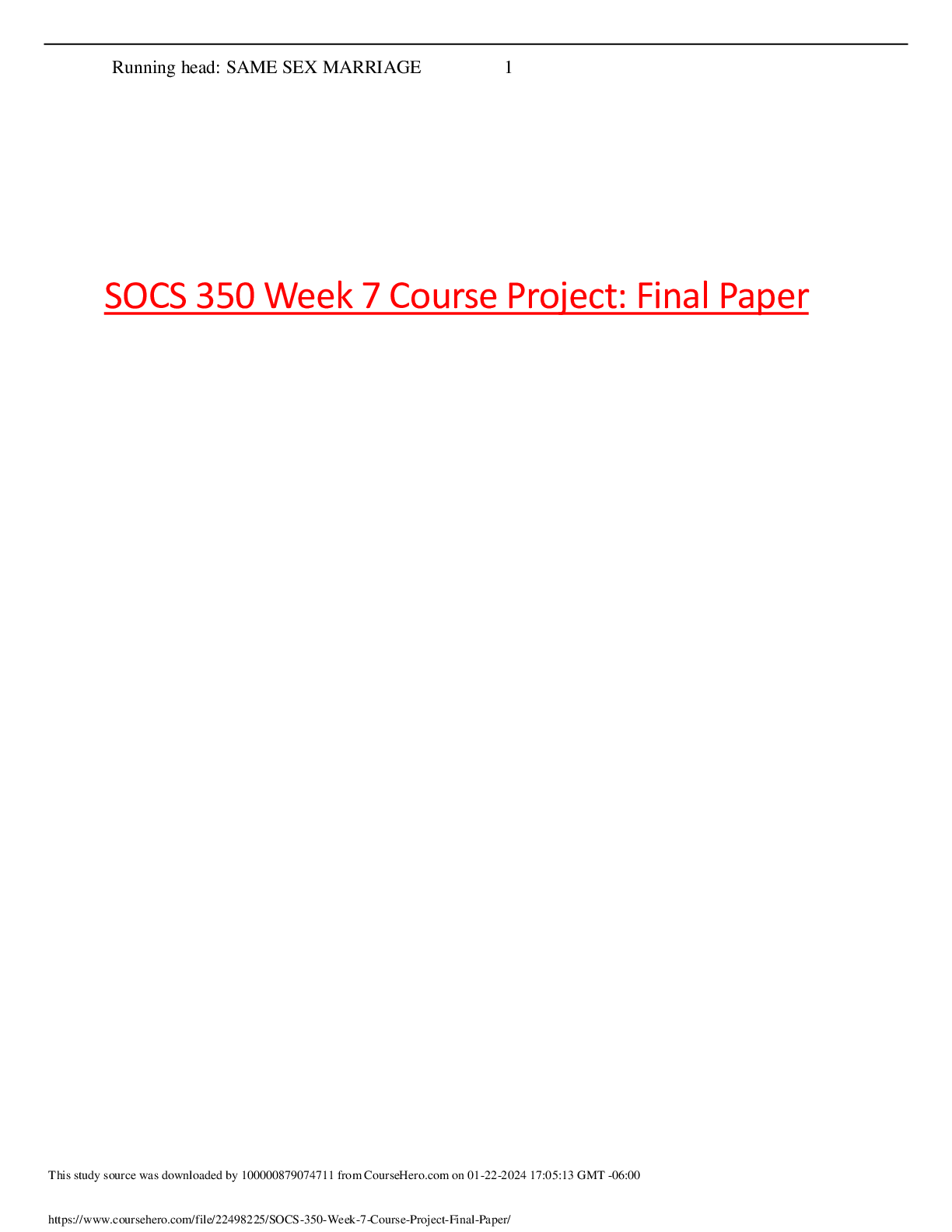

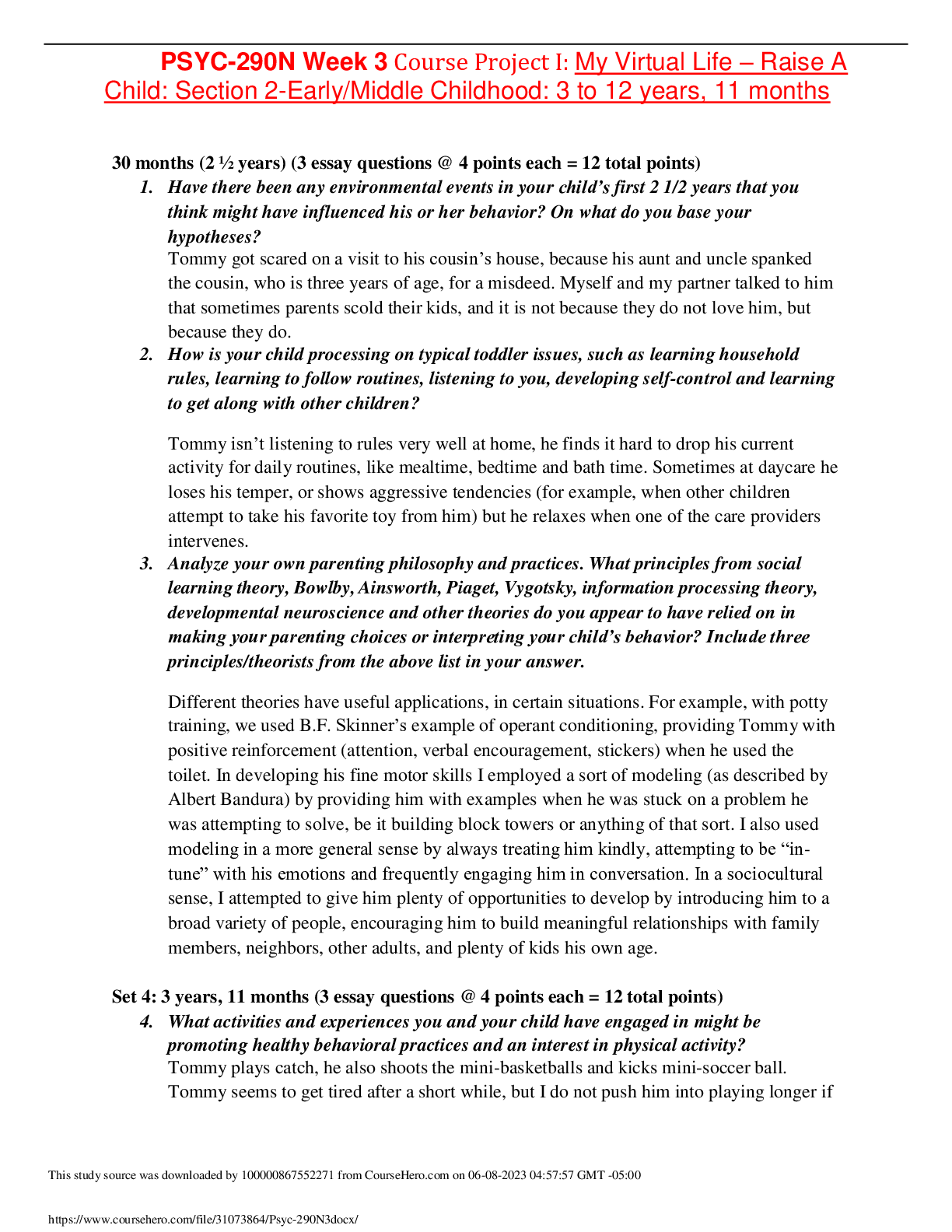


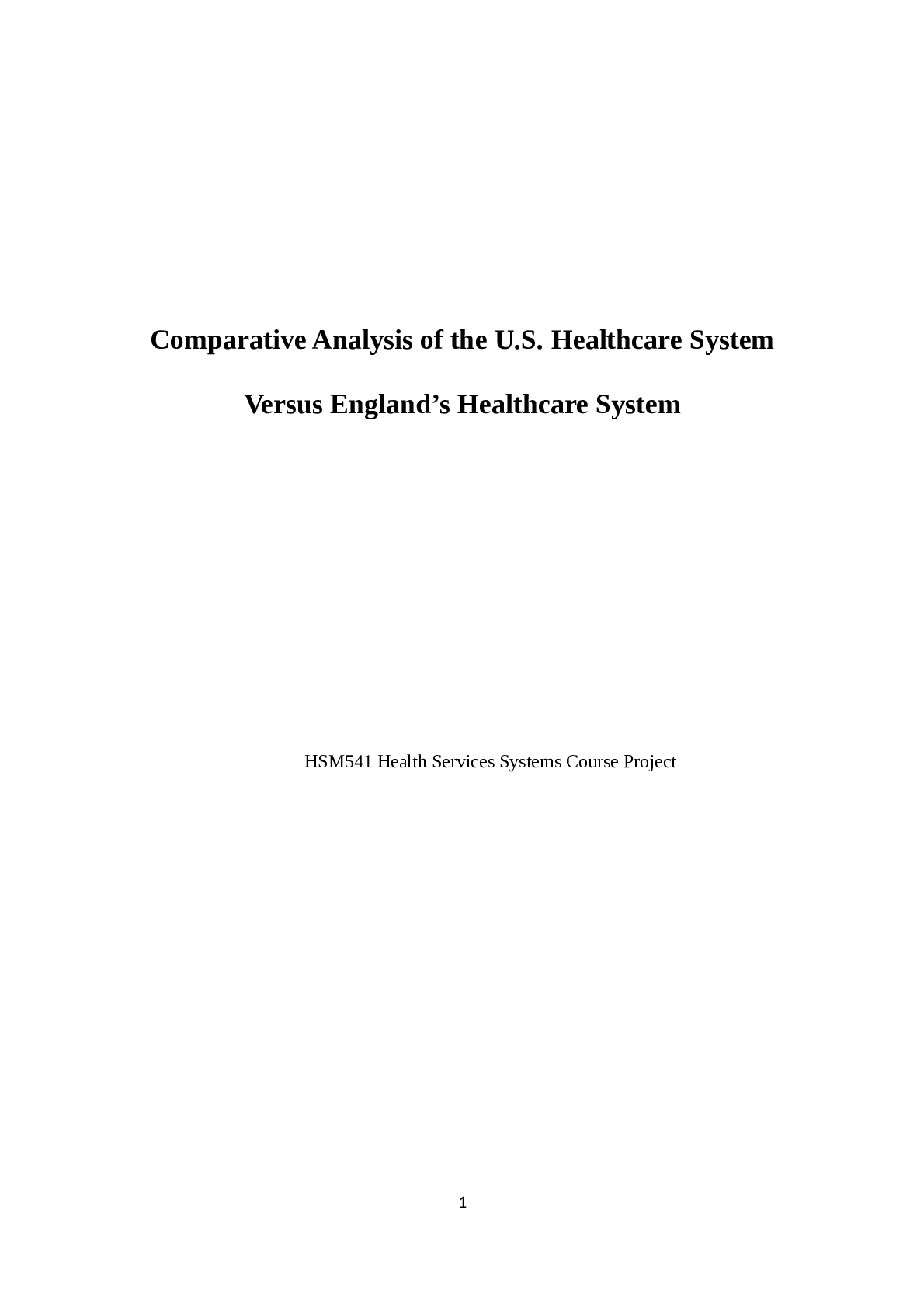

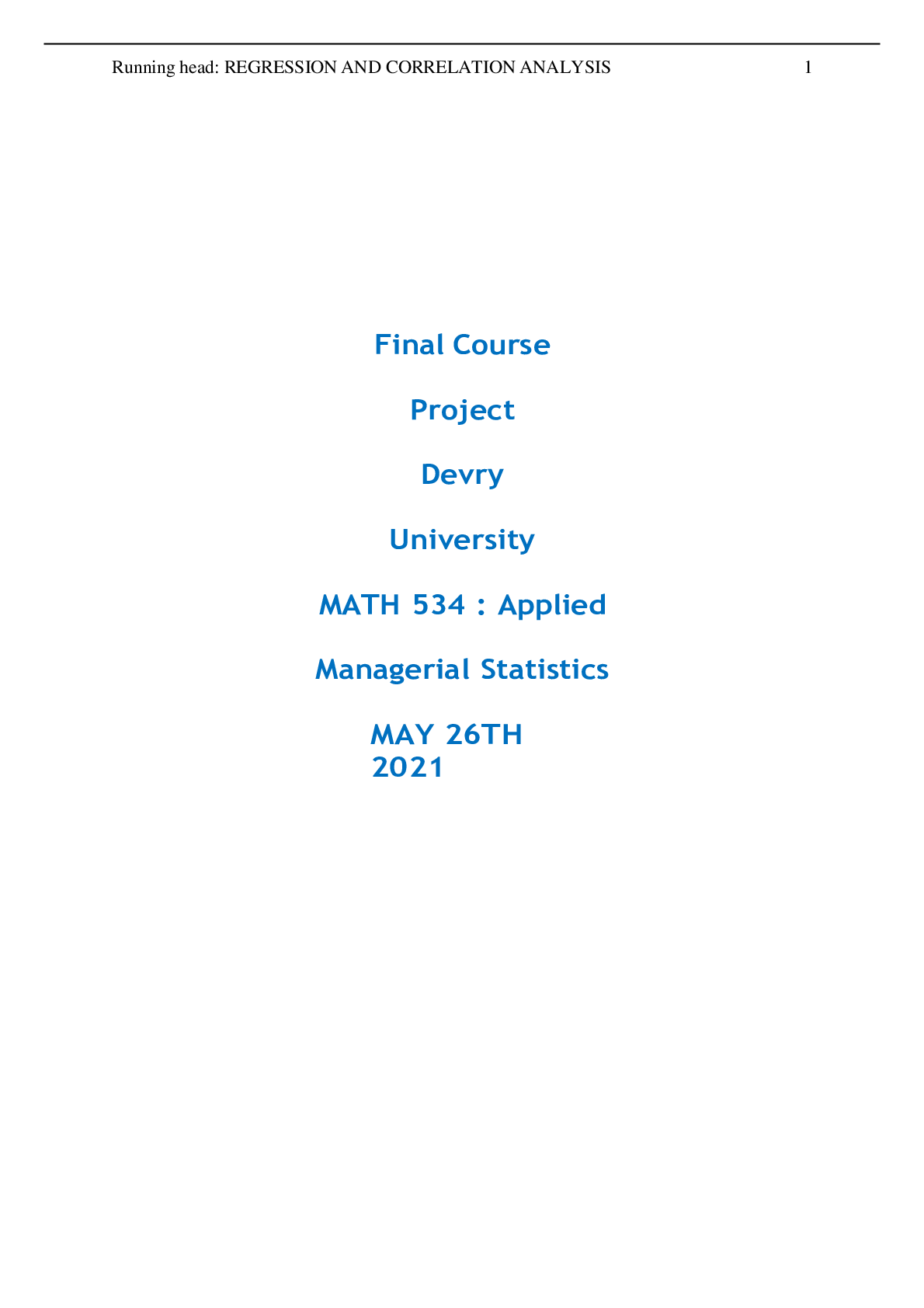

.png)
